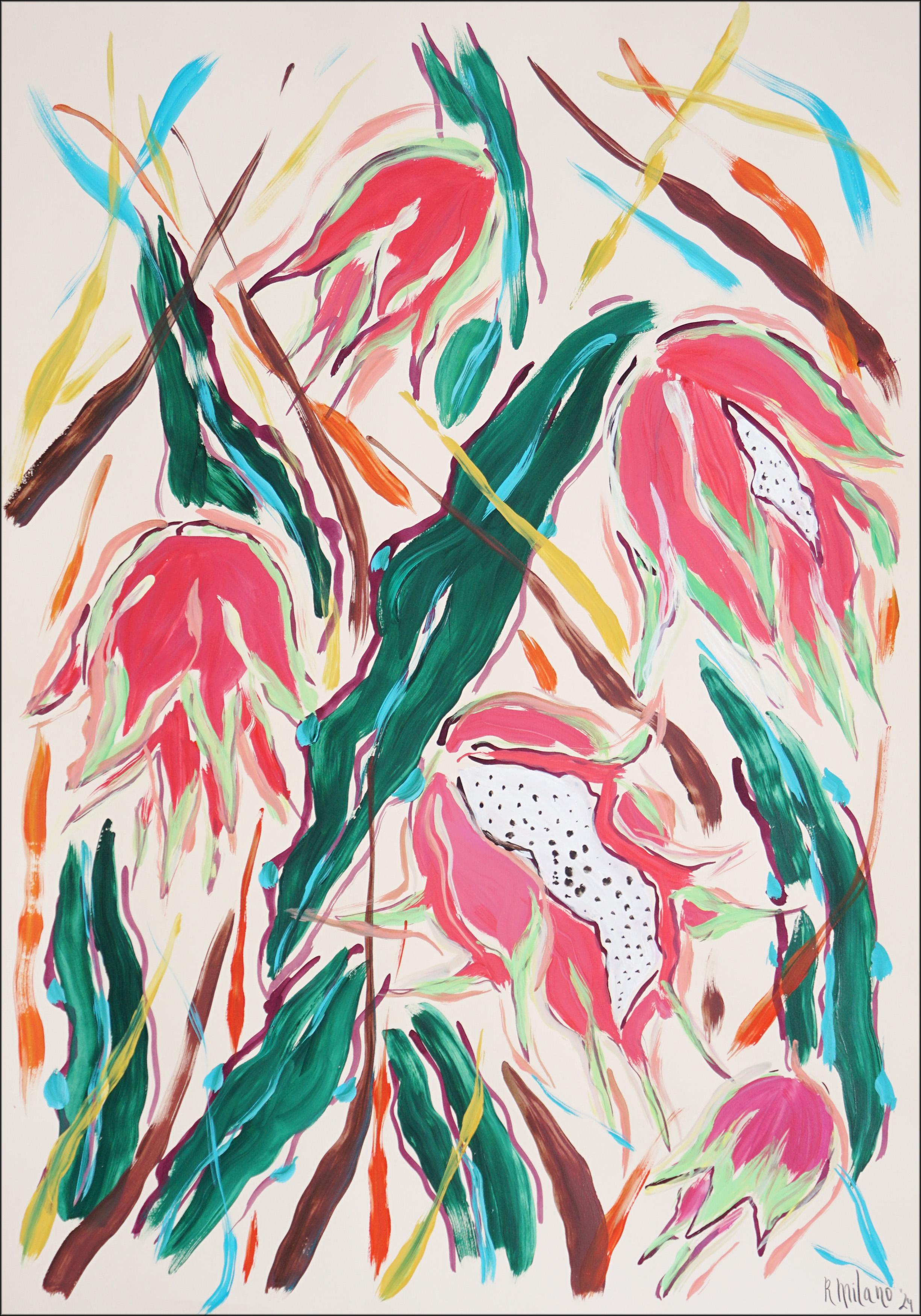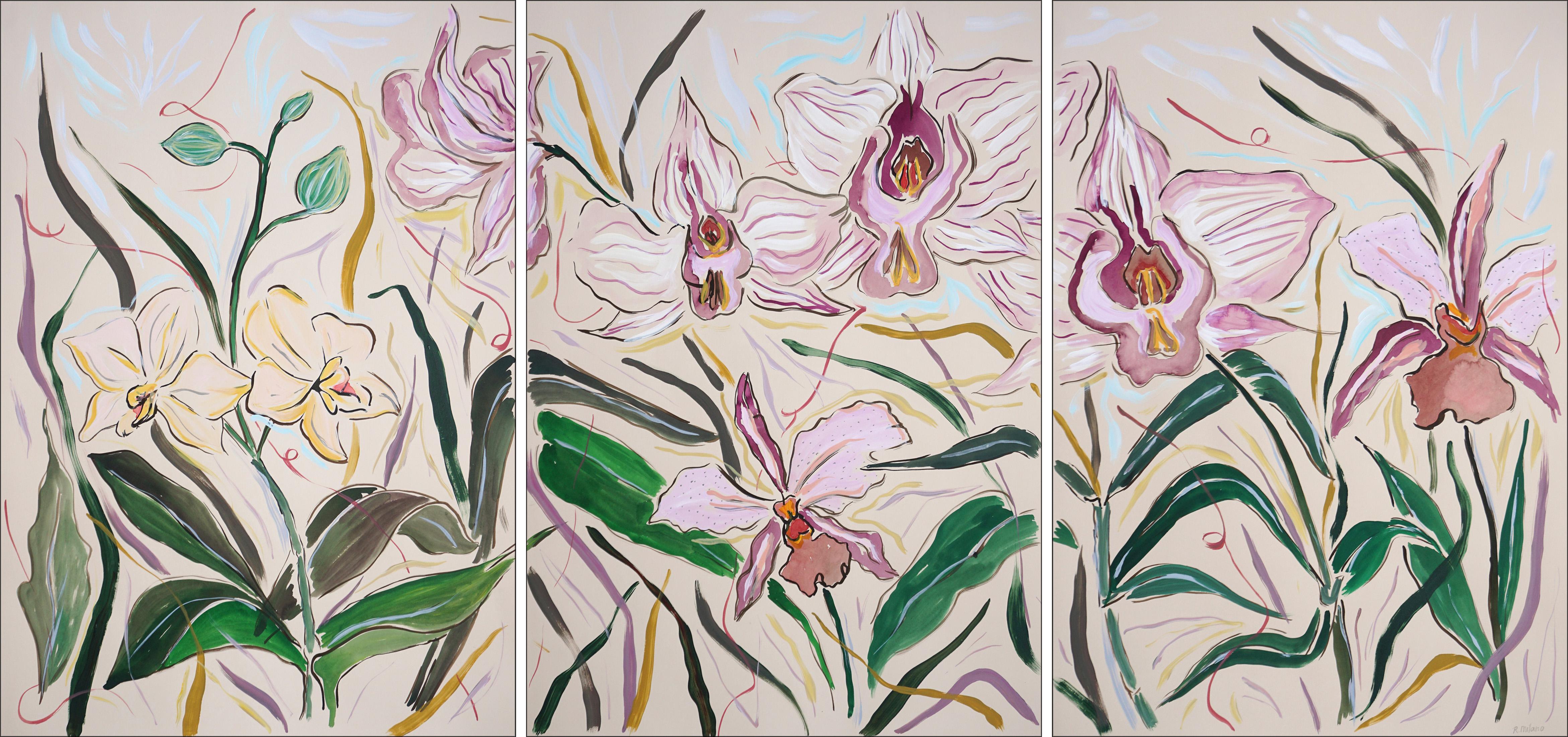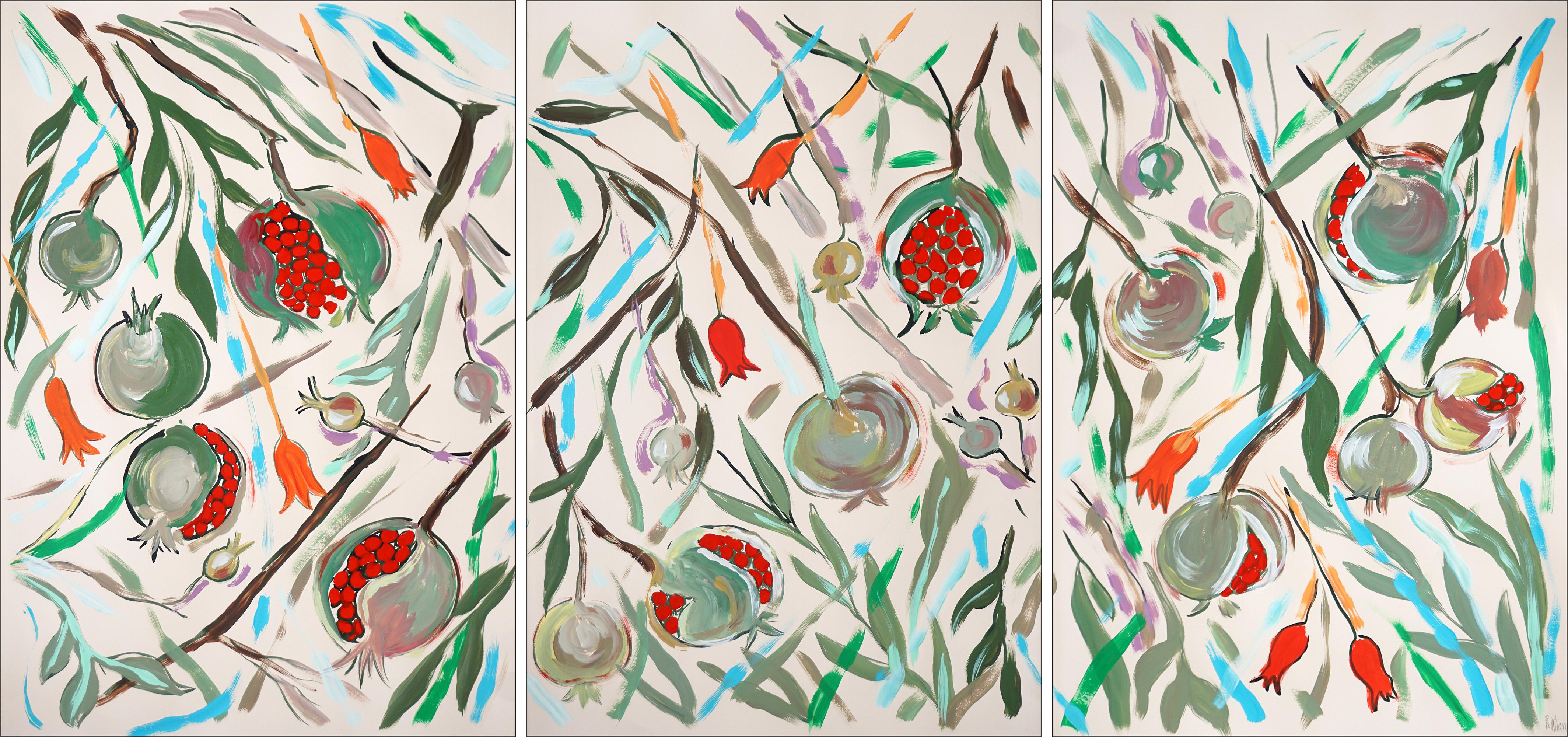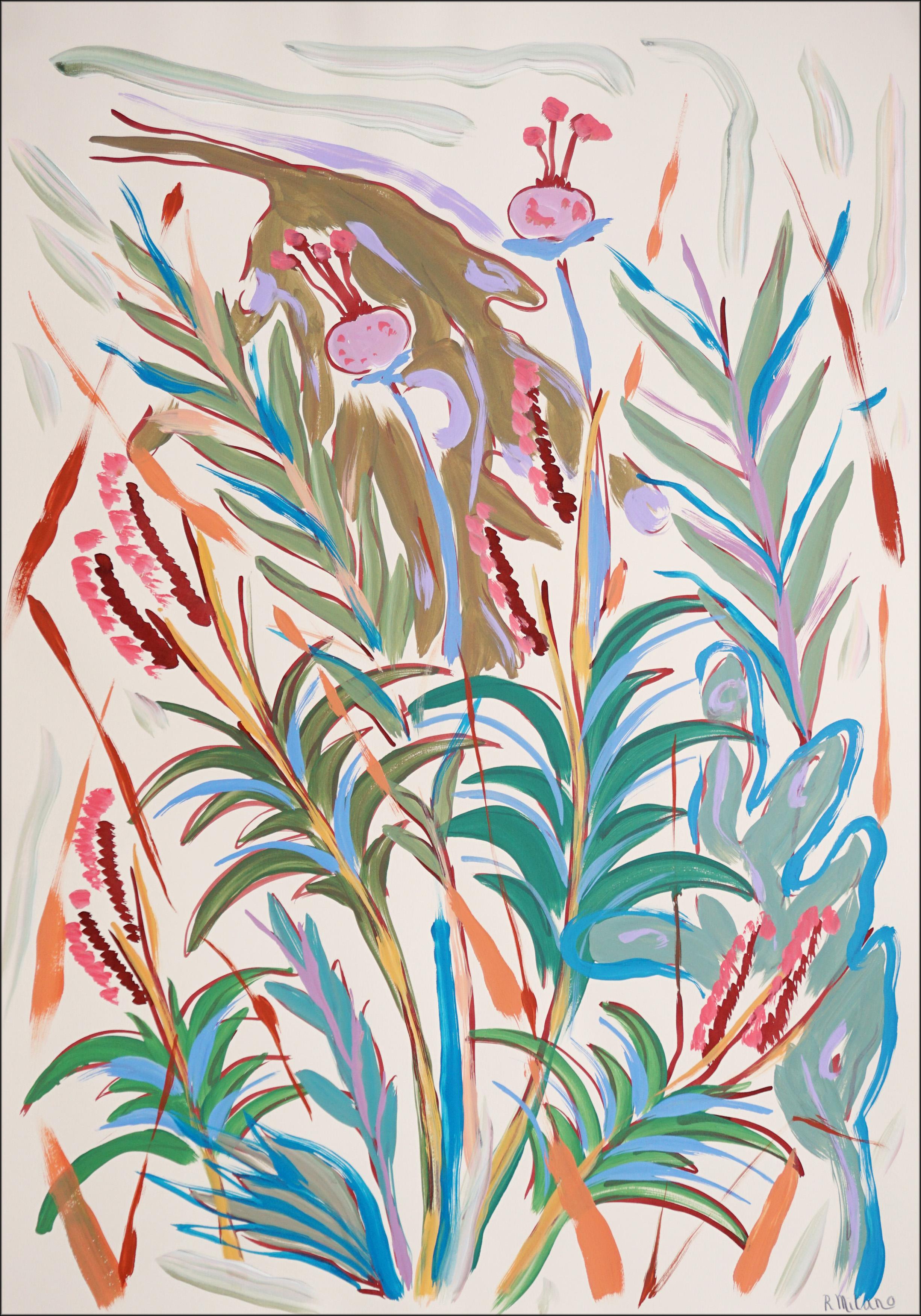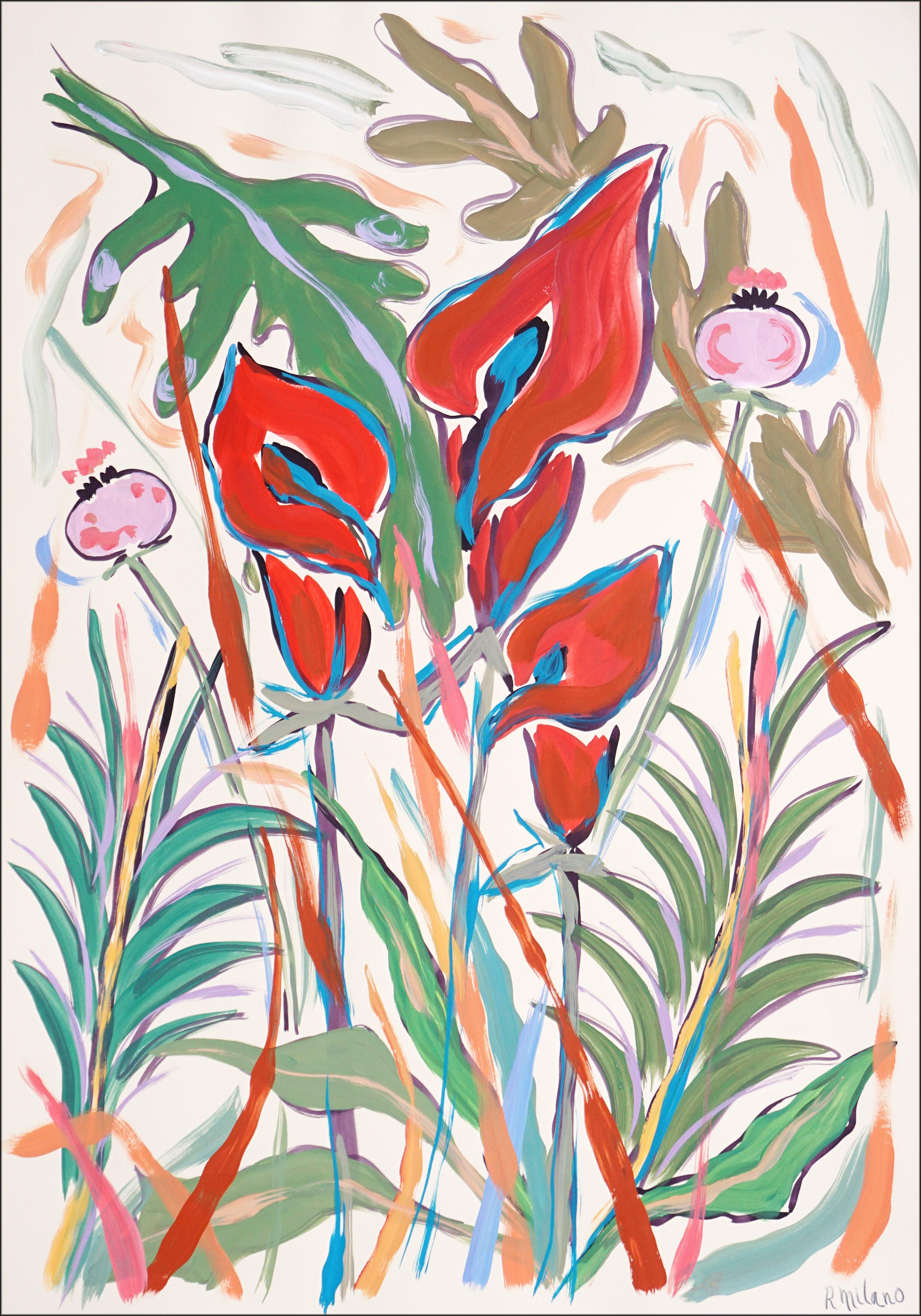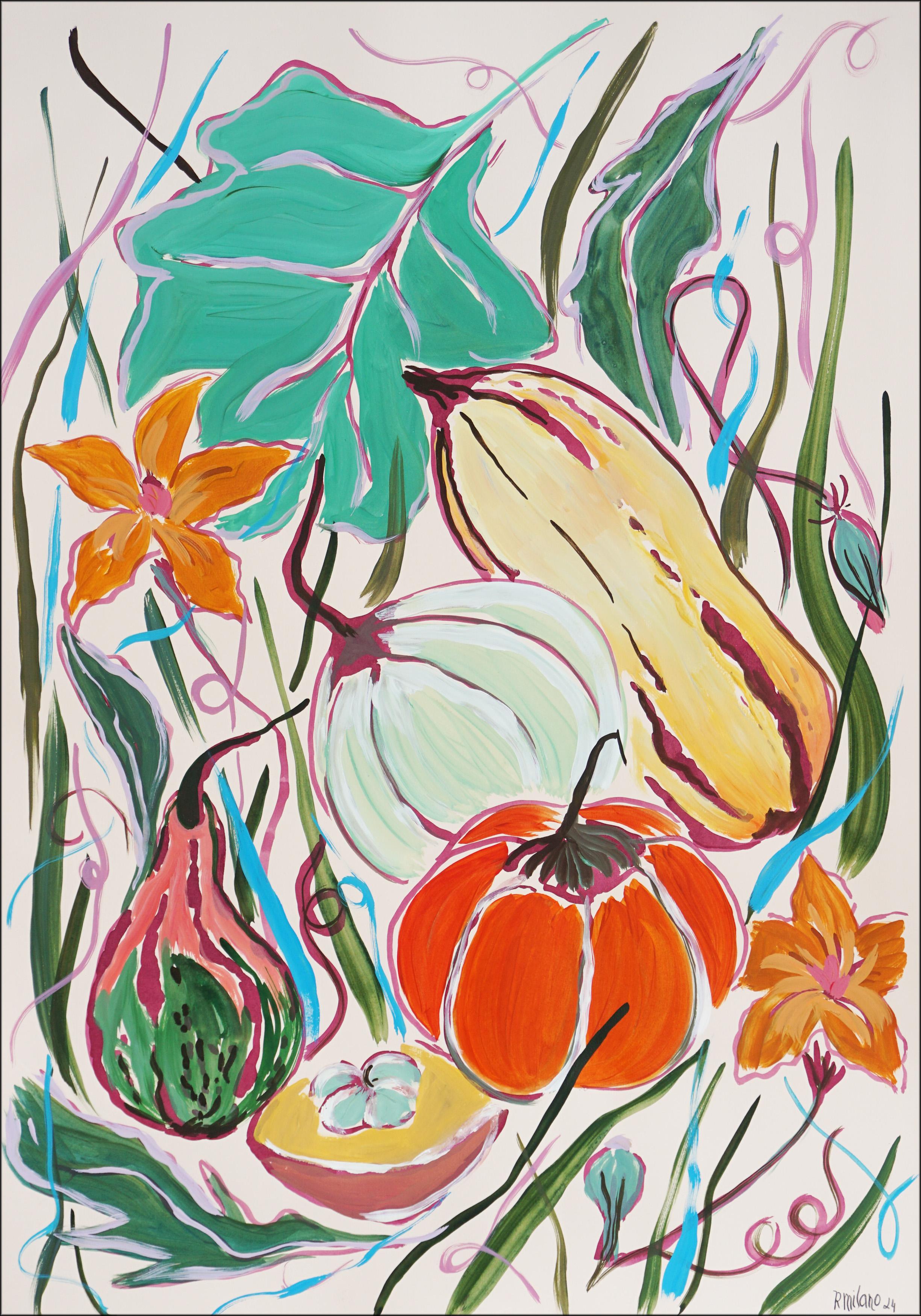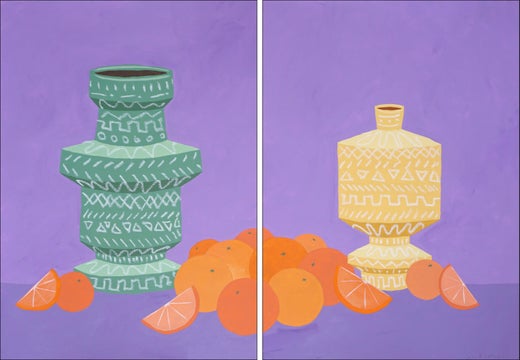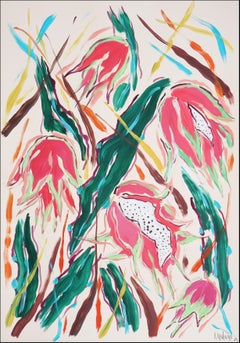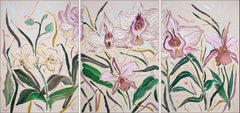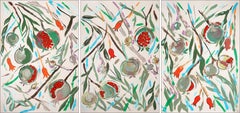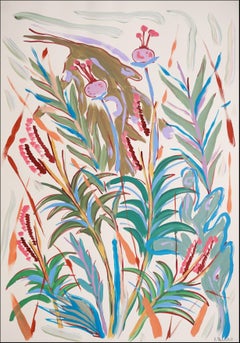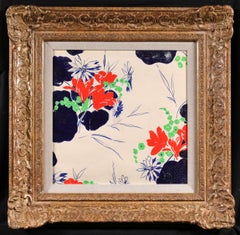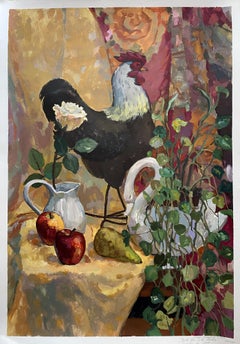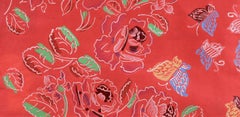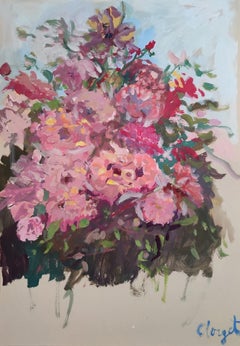Items Similar to Bottle Collection, Bright Tones Still-life Tableware Silhouette, Soft Pink Green
Video Loading
Want more images or videos?
Request additional images or videos from the seller
1 of 12
Gio BellagioBottle Collection, Bright Tones Still-life Tableware Silhouette, Soft Pink Green2023
2023
About the Item
"Bottle Collection I" is a modern still-life that portrays a collection of bottles and china items that are arranged in a harmonious composition against a soft baby blue background. Each object has a unique character and unique sculptural qualities suggesting the beauty of simple objects. The use of pastel tones adds a sense of delicacy and refinement to the scene, evoking a feeling of calm and serenity.
Details:
Title: Bottle Collection I
Medium: Acrylic on Paper
Size: 70x50 cm, (28x20 inches)
Year: 2023
* Frame is for illustrative purposes only. Artwork shipped carefully rolled and packaged in a tube.
* Certificate of Authenticity provided.
Gio Bellagio is a contemporary painter born in northern Italy in 1984. Drawing inspiration from the works of Gorgio Morandi, sculptor Modigliani, and pop and art deco pastel colors, Belaggio creates semi-abstract modern paintings that experiment with color and form.
Bellagio's work is characterized by its semi-abstract style and modern aesthetic. His paintings are known for their use of soft colors and bold forms, creating a dreamlike quality that transports the viewer to another world.
Bellagio's paintings and prints are highly sought after by collectors and art enthusiasts alike, with many of his pieces being displayed in both modern and chic homes. His works draw inspiration from the deep history of design in northern Italy, making them the perfect addition to any space with an appreciation for great design.
- Creator:Gio Bellagio (1984, Italian)
- Creation Year:2023
- Dimensions:Height: 28 in (71.12 cm)Width: 20 in (50.8 cm)Depth: 0.1 in (2.54 mm)
- Medium:
- Movement & Style:
- Period:
- Condition:
- Gallery Location:Barcelona, ES
- Reference Number:Seller: B0341stDibs: LU1310212066032
Gio Bellagio is a contemporary painter born in northern Italy in 1984. Drawing inspiration from the works of Gorgio Morandi, sculptor Modigliani, and pop and art deco pastel colors, Belaggio creates semi-abstract modern paintings that experiment with color and form. Bellagio's work is characterized by its semi-abstract style and modern aesthetic. His paintings are known for their use of soft colors and bold forms, creating a dreamlike quality that transports the viewer to another world. Bellagio's paintings and prints are highly sought after by collectors and art enthusiasts alike, with many of his pieces being displayed in both modern and chic homes. His works draw inspiration from the deep history of design in northern Italy, making them the perfect addition to any space with an appreciation for great design.
About the Seller
4.9
Platinum Seller
Premium sellers with a 4.7+ rating and 24-hour response times
Established in 2016
1stDibs seller since 2019
664 sales on 1stDibs
Typical response time: 1 hour
- ShippingRetrieving quote...Shipping from: Barcelona, Spain
- Return Policy
Authenticity Guarantee
In the unlikely event there’s an issue with an item’s authenticity, contact us within 1 year for a full refund. DetailsMoney-Back Guarantee
If your item is not as described, is damaged in transit, or does not arrive, contact us within 7 days for a full refund. Details24-Hour Cancellation
You have a 24-hour grace period in which to reconsider your purchase, with no questions asked.Vetted Professional Sellers
Our world-class sellers must adhere to strict standards for service and quality, maintaining the integrity of our listings.Price-Match Guarantee
If you find that a seller listed the same item for a lower price elsewhere, we’ll match it.Trusted Global Delivery
Our best-in-class carrier network provides specialized shipping options worldwide, including custom delivery.More From This Seller
View AllIllustration Style Still Life Painting of Pink Dragon Fruit Tree, Botanical Art
Located in Barcelona, ES
"Dragon Fruit Bush" is an abstract expressionist painting by Romina Milano where a dance of black gestures unfolds across colorful brushstrokes infused with raw emotion.
Romina Mil...
Category
2010s Fauvist Landscape Paintings
Materials
India Ink, Acrylic, Rag Paper
Pink Orchid Bloom Triptych, Large Flowers, Wild Tropical Nature in Soft Purple
Located in Barcelona, ES
"Pink Orchid Bloom I" is an abstract expressionist painting by Romina Milano where a dance of gestures unfolds across colorful brushstrokes infused with raw emotion.
Romina Milano ...
Category
2010s Fauvist Landscape Paintings
Materials
Acrylic, India Ink, Rag Paper
Botanical Illustration of Ripe Pomegranates Triptych, Fruit Tree, Watercolor
Located in Barcelona, ES
"Ripe Pomegranates III" is an illustration style painting by Romina Milano where a dance of gestures unfolds across colorful landscapes.
Romina Milano is an Italian artist renowned...
Category
2010s Fauvist Landscape Paintings
Materials
Acrylic, Watercolor, Paper
Tropical Garden, Expressionist Green Plants, Jurassic, Botanical Painting, Paper
Located in Barcelona, ES
"Tropical Garden" is an illustration style painting of tropical jungle plants. Vibrant greens, expressionist gestures, and intricate textures come together in this artwork to create...
Category
2010s Fauvist Landscape Paintings
Materials
Acrylic, Watercolor, Paper
Anthuriums and Poppies, Fauvist Landscape, Flowers Bouquet, Illustration Style
Located in Barcelona, ES
"Anthuriums and Poppies" is an illustration style painting of exotic flowers bouquet. Red flowers, expressionist gestures, and intricate textures come together in this artwork to cr...
Category
2010s Fauvist Landscape Paintings
Materials
Paper, Acrylic, Watercolor
Illustration Painting of Autumn Pumpkins Harvest, Orange Tones India Ink, Paper
Located in Barcelona, ES
"Autumn Harvest III" is an abstract expressionist painting by Romina Milano where a dance of black gestures unfolds across colorful brushstrokes infused with raw emotion.
Romina Mi...
Category
2010s Fauvist Landscape Paintings
Materials
India Ink, Acrylic, Watercolor
You May Also Like
Projet de Tissus - Fauvist Flowers Watercolor & Gouache by Raoul Dufy
By Raoul Dufy
Located in Marlow, Buckinghamshire
Botanical watercolour and gouache on paper circa 1920 by French fauvist painter Raoul Dufy. The work depicts flowers in red, blue and green. This work was executed by Dufy as a fabric design.
Dimensions:
Framed: 19.5"x19.5"
Unframed: 12"x12"
Provenance:
Private collection of works by Raoul Dufy for Bianchini Ferier
Bianchini Ferrier Collection - Christie's London - July 2001
SF Fall Show
Raoul Dufy was one of a family of nine children, including five sisters and a younger brother, Jean Dufy, also destined to become a painter. Their father was an accountant in the employ of a major company in Le Havre. The Dufy family was musically gifted: his father was an organist, as was his brother Léon, and his youngest brother Gaston was an accomplished flautist who later worked as a music critic in Paris. Raoul Dufy's studies were interrupted at the age of 14, when he had to contribute to the family income. He took a job with an importer of Brazilian coffee, but still found time from 1892 to attend evening courses in drawing and composition at the local college of fine arts under Charles Marie Lhullier, former teacher of Othon Friesz and Georges Braque. He spent his free time in museums, admiring the paintings of Eugène Boudin in Le Havre and The Justice of Trajan in Rouen. A municipal scholarship enabled him to leave for Paris in 1900, where he lodged initially with Othon Friesz. He was accepted by the École des Beaux-Arts, where he studied under Léon Bonnat, whose innate conservatism prompted Dufy to remark later that it was 'good to be at the Beaux-Arts providing one knew one could leave'.
And leave he did, four years later, embarking with friends and fellow students on the rounds of the major Paris galleries - Ambroise Vollard, Durand-Ruel, Eugène Blot and Berheim-Jeune. For Dufy and his contemporaries, Impressionism represented a rejection of sterile academism in favour of the open-air canvases of Manet, the light and bright colours of the Impressionists, and, beyond them, the daringly innovative work of Gauguin and Van Gogh, Seurat, Cézanne, Toulouse-Lautrec and others. Dufy was an out-and-out individualist, however, and was not tempted to imitate any of these artists. He produced, between 1935 and 1937, Fée Electricité (Spirit of Electricity), the emblem for the French utilities company Electricité de France (EDF).
Dufy visited the USA for the first time in 1937, as a member of the Carnegie Prize jury. In 1940, the outbreak of war (and his increasingly rheumatic condition) persuaded him to settle in Nice. When he eventually returned to Paris 10 years later, his rheumatism had become so debilitating that he immediately left for Boston to follow a course of pioneering anti-cortisone treatment. He continued working, however, spending time first in Harvard and then in New York City before moving to the drier climate of Tucson, Arizona. The cortisone treatment was by and large unsuccessful, although he did recover the use of his fingers. He returned to Paris in 1951 and decided to settle in Forcalquier, where the climate was more clement. Within a short time, however, he was wheelchair-bound. He died in Forcalquier in March 1953 and was buried in Cimiez.
Between 1895 and 1898, Raoul Dufy painted watercolours of landscapes near his native Le Havre and around Honfleur and Falaise. By the turn of the century, however, he was already painting certain subjects that were to become hallmarks of his work - flag-decked Parisian cityscapes, Normandy beaches teeming with visitors, regattas and the like, including one of his better-known early works, Landing Stage at Ste-Adresse. By 1905-1906 Friesz, Braque, Matisse, Derain, Vlaminck, Van Dongen and Rouault were described collectively as Fauves (the wild beasts). What they had in common was a desire to innovate, but they felt constrained nonetheless to meet formally to set out the guiding principles of what promised to be a new 'movement'. Dufy quickly established that those principles were acceptable; moreover, he was most impressed by one particular painting by Henri Matisse ( Luxury, Calm and Voluptuousness) which, to Dufy, embodied both novelty and a sense of artistic freedom. Dufy promptly aligned himself with the Fauves. Together with Albert Marquet in particular, he spent his time travelling the Normandy coast and painting views similar...
Category
1920s Fauvist Still-life Drawings and Watercolors
Materials
Paper, Watercolor, Gouache
Still life with chicken
Located in Oslo, NO
In this painting, I infused the vitality of nature and domestic tranquility through bold strokes and vibrant gouache colors. The rooster stands proudly, symbolizing wakefulness and t...
Category
2010s Fauvist Still-life Paintings
Materials
Gouache, Bamboo Paper
Fleurs et Papillons - Fauvist Flowers Watercolor & Gouache by Raoul Dufy
By Raoul Dufy
Located in Marlow, Buckinghamshire
Botanical watercolour and gouache on paper circa 1920 by French fauvist painter Raoul Dufy. The work depicts flowers in red and butterflies in blues, yellows, black and white. This work was executed by Dufy as a fabric design.
Dimensions:
Framed: 17"x27"
Unframed: 10"x20"
Provenance:
Private collection of works by Raoul Dufy for Bianchini Ferier
Bianchini Ferrier Collection - Christie's London - July 2001
SF Fall Show
Raoul Dufy was one of a family of nine children, including five sisters and a younger brother, Jean Dufy, also destined to become a painter. Their father was an accountant in the employ of a major company in Le Havre. The Dufy family was musically gifted: his father was an organist, as was his brother Léon, and his youngest brother Gaston was an accomplished flautist who later worked as a music critic in Paris. Raoul Dufy's studies were interrupted at the age of 14, when he had to contribute to the family income. He took a job with an importer of Brazilian coffee, but still found time from 1892 to attend evening courses in drawing and composition at the local college of fine arts under Charles Marie Lhullier, former teacher of Othon Friesz and Georges Braque. He spent his free time in museums, admiring the paintings of Eugène Boudin in Le Havre and The Justice of Trajan in Rouen. A municipal scholarship enabled him to leave for Paris in 1900, where he lodged initially with Othon Friesz. He was accepted by the École des Beaux-Arts, where he studied under Léon Bonnat, whose innate conservatism prompted Dufy to remark later that it was 'good to be at the Beaux-Arts providing one knew one could leave'.
And leave he did, four years later, embarking with friends and fellow students on the rounds of the major Paris galleries - Ambroise Vollard, Durand-Ruel, Eugène Blot and Berheim-Jeune. For Dufy and his contemporaries, Impressionism represented a rejection of sterile academism in favour of the open-air canvases of Manet, the light and bright colours of the Impressionists, and, beyond them, the daringly innovative work of Gauguin and Van Gogh, Seurat, Cézanne, Toulouse-Lautrec and others. Dufy was an out-and-out individualist, however, and was not tempted to imitate any of these artists. He produced, between 1935 and 1937, Fée Electricité (Spirit of Electricity), the emblem for the French utilities company Electricité de France (EDF).
Dufy visited the USA for the first time in 1937, as a member of the Carnegie Prize jury. In 1940, the outbreak of war (and his increasingly rheumatic condition) persuaded him to settle in Nice. When he eventually returned to Paris 10 years later, his rheumatism had become so debilitating that he immediately left for Boston to follow a course of pioneering anti-cortisone treatment. He continued working, however, spending time first in Harvard and then in New York City before moving to the drier climate of Tucson, Arizona. The cortisone treatment was by and large unsuccessful, although he did recover the use of his fingers. He returned to Paris in 1951 and decided to settle in Forcalquier, where the climate was more clement. Within a short time, however, he was wheelchair-bound. He died in Forcalquier in March 1953 and was buried in Cimiez.
Between 1895 and 1898, Raoul Dufy painted watercolours of landscapes near his native Le Havre and around Honfleur and Falaise. By the turn of the century, however, he was already painting certain subjects that were to become hallmarks of his work - flag-decked Parisian cityscapes, Normandy beaches teeming with visitors, regattas and the like, including one of his better-known early works, Landing Stage at Ste-Adresse. By 1905-1906 Friesz, Braque, Matisse, Derain, Vlaminck, Van Dongen and Rouault were described collectively as Fauves (the wild beasts). What they had in common was a desire to innovate, but they felt constrained nonetheless to meet formally to set out the guiding principles of what promised to be a new 'movement'. Dufy quickly established that those principles were acceptable; moreover, he was most impressed by one particular painting by Henri Matisse ( Luxury, Calm and Voluptuousness) which, to Dufy, embodied both novelty and a sense of artistic freedom. Dufy promptly aligned himself with the Fauves. Together with Albert Marquet in particular, he spent his time travelling the Normandy coast and painting views similar...
Category
1920s Fauvist Still-life Drawings and Watercolors
Materials
Paper, Watercolor, Gouache
Floral gouache impressionist 'Always Roses' by Linda Clerget
Located in THOMERY, FR
The work of Linda Clerget is realized in an impressionist style à la gouache alla prima. The colors are broken and worked in the fresh.
Linda Clerget is a French artist known intern...
Category
21st Century and Contemporary Fauvist Still-life Drawings and Watercolors
Materials
Archival Paper, Gouache
Projet de Fleurs - Fauvist Flowers Gouache by Raoul Dufy
By Raoul Dufy
Located in Marlow, Buckinghamshire
Botanical gouache on paper circa 1920 by French fauvist painter Raoul Dufy. The work flowers in red and blues with green foliage against a yellow and white stripped background.
Dimensions:
Framed: 25"x20"
Unframed: 18"x13"
Raoul Dufy was one of a family of nine children, including five sisters and a younger brother, Jean Dufy, also destined to become a painter. Their father was an accountant in the employ of a major company in Le Havre. The Dufy family was musically gifted: his father was an organist, as was his brother Léon, and his youngest brother Gaston was an accomplished flautist who later worked as a music critic in Paris. Raoul Dufy's studies were interrupted at the age of 14, when he had to contribute to the family income. He took a job with an importer of Brazilian coffee, but still found time from 1892 to attend evening courses in drawing and composition at the local college of fine arts under Charles Marie Lhullier, former teacher of Othon Friesz and Georges Braque. He spent his free time in museums, admiring the paintings of Eugène Boudin in Le Havre and The Justice of Trajan in Rouen. A municipal scholarship enabled him to leave for Paris in 1900, where he lodged initially with Othon Friesz. He was accepted by the École des Beaux-Arts, where he studied under Léon Bonnat, whose innate conservatism prompted Dufy to remark later that it was 'good to be at the Beaux-Arts providing one knew one could leave'.
And leave he did, four years later, embarking with friends and fellow students on the rounds of the major Paris galleries - Ambroise Vollard, Durand-Ruel, Eugène Blot and Berheim-Jeune. For Dufy and his contemporaries, Impressionism represented a rejection of sterile academism in favour of the open-air canvases of Manet, the light and bright colours of the Impressionists, and, beyond them, the daringly innovative work of Gauguin and Van Gogh, Seurat, Cézanne, Toulouse-Lautrec and others. Dufy was an out-and-out individualist, however, and was not tempted to imitate any of these artists. He produced, between 1935 and 1937, Fée Electricité (Spirit of Electricity), the emblem for the French utilities company Electricité de France (EDF).
Dufy visited the USA for the first time in 1937, as a member of the Carnegie Prize jury. In 1940, the outbreak of war (and his increasingly rheumatic condition) persuaded him to settle in Nice. When he eventually returned to Paris 10 years later, his rheumatism had become so debilitating that he immediately left for Boston to follow a course of pioneering anti-cortisone treatment. He continued working, however, spending time first in Harvard and then in New York City before moving to the drier climate of Tucson, Arizona. The cortisone treatment was by and large unsuccessful, although he did recover the use of his fingers. He returned to Paris in 1951 and decided to settle in Forcalquier, where the climate was more clement. Within a short time, however, he was wheelchair-bound. He died in Forcalquier in March 1953 and was buried in Cimiez.
Between 1895 and 1898, Raoul Dufy painted watercolours of landscapes near his native Le Havre and around Honfleur and Falaise. By the turn of the century, however, he was already painting certain subjects that were to become hallmarks of his work - flag-decked Parisian cityscapes, Normandy beaches teeming with visitors, regattas and the like, including one of his better-known early works, Landing Stage at Ste-Adresse. By 1905-1906 Friesz, Braque, Matisse, Derain, Vlaminck, Van Dongen and Rouault were described collectively as Fauves (the wild beasts). What they had in common was a desire to innovate, but they felt constrained nonetheless to meet formally to set out the guiding principles of what promised to be a new 'movement'. Dufy quickly established that those principles were acceptable; moreover, he was most impressed by one particular painting by Henri Matisse ( Luxury, Calm and Voluptuousness) which, to Dufy, embodied both novelty and a sense of artistic freedom. Dufy promptly aligned himself with the Fauves. Together with Albert Marquet in particular, he spent his time travelling the Normandy coast and painting views similar...
Category
1920s Fauvist Still-life Drawings and Watercolors
Materials
Paper, Gouache
Projet de Tissus - Fauvist Still Life Study Gouache by Raoul Dufy
By Raoul Dufy
Located in Marlow, Buckinghamshire
Botanical gouache on paper circa 1920 by French fauvist painter Raoul Dufy. The work depicts a study of apples and pears. This work was executed by Dufy as a fabric design.
Dimensio...
Category
1920s Fauvist Still-life Drawings and Watercolors
Materials
Paper, Gouache
